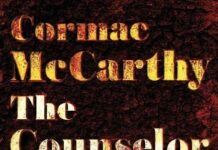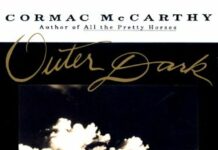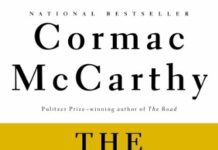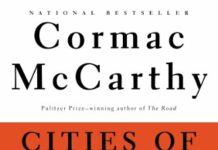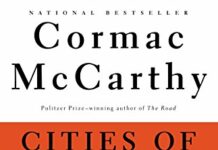
Ebook Info
- Published: 2010
- Number of pages: 349 pages
- Format: EPUB
- File Size: 1.88 MB
- Authors: Cormac McCarthy
Description
25th ANNIVERSARY EDITION • An epic novel of the violence and depravity that attended America’s westward expansion, Blood Meridian brilliantly subverts the conventions of the Western novel and the mythology of the Wild West—from the bestselling, Pulitzer Prize–winning author of The RoadBased on historical events that took place on the Texas-Mexico border in the 1850s, it traces the fortunes of the Kid, a fourteen-year-old Tennesseean who stumbles into the nightmarish world where Indians are being murdered and the market for their scalps is thriving.Look for Cormac McCarthy’s new novel, The Passenger.
User’s Reviews
Reviews from Amazon users which were colected at the time this book was published on the website:
⭐The central character in Cormac McCarthy’s “Blood Meridian” says at one point, “Whatever exists in creation without my knowledge exists without my consent”. The book that details his journey surely seems like it could not have existed without his knowledge and consent.There are a few universals that fill a McCarthy novel: the crudity and Neo-Biblical, fire-and-brimstone bleakness of human sagas with no respite in sight, the almost complete absence of women, the haunting, bone-chilling, lyrical physical descriptions of nature and devastated landscapes, the metaphors literally dripping from every sentence, and – ubiquitously so – the brutal violence and desperation. But “Blood Meridian” stretches each one of these plot devices to the breaking point. Critics have universally praised it as one of the best American novels of the past 25 years and heavyweights like Harold Bloom have said it’s the most significant encapsulation of all of human frailty and triumph since ‘Moby Dick’. Yet it remains one of the most complex, challenging and exhausting works of fiction I have ever read, and this feeling seems to be widespread.It’s certainly the most extraordinarily violent. The violence here is mind-numbing, routine-as-rain and runs on every page like fresh blood pulsing through a healthy artery. For several days when I was reading and re-reading the book, the story was lodged like a splinter in my brain, not letting go even when I was away from it; as one reviewer of the volume put it, there is no safe space (not in the contemporary sense of the term) from which you can watch what unfolds. But it was the kind of splinter whose pain and beauty you want to feel before you finally dislodge it in a final act of defiance. And even though I read it as carefully as I could, there are parts I will have to read again so that I can fully digest their mystical properties. When I finished I was glad to be done with it and just felt like sleeping, and yet I will re-read it at some point in time; it’s a bone-rattling wine that makes you sick but ages with time and contains mysteries that are still waiting to be plumbed.The book is challenging and exhausting for several reasons. The plot is set in 1840s Texas, Mexico and the American Southwest, and the language is often a bastardized mix of English and Spanish from that era; if you understand Spanish you will have a leg up. But that’s the least of the obstacles. Anyone who has read McCarthy knows how a single one of his sentences routinely fills an entire paragraph or even entire pages. Not just this, but these sentences can consist of garbled verbs and nouns and sometimes words that are pure inventions: there was more than one occasion when I looked up a word in a dictionary, only to find that just like McCarthy’s fevered creations, it’s a phantasmagorical thing that only exists in the heaven and hell of his characters. There is plenty of free association in the book, but somehow, this free association often congeals into a kind of mesmerizing, rhythmic meter.The basic story centers on a boy of 14 years who joins a gang of bounty hunters who are hungry for Indian scalps. They ride on through the American southwest, regularly encountering various tribes of Indians and massacring them, scalping them, and parading these bloodied trophies around. In the process they also kill, maim and mow down hundreds of innocent men, women and children who have done them no harm. After each of these “missions” they ride back into town, collect their bounty and revel in a night of drunken excess and destruction before setting off on their next bloodthirsty trip through bleak and cruel lands. Like many other McCarthy stories, this begins in mid-stride, seemingly without a beginning and a background, wrenched from the orderly march of destiny. Who is the kid? Where does he come from? What is the historical context in which he lives in his life? None of this really matters. His actions simply are.Although the story centers on the kid, the main character is a man called the Judge who has to be one of the most fascinating characters in all of fiction. He is a terrifying, large, sweaty, bald, crude hulk of a violent creature, capable of crushing heads simply by squeezing them. Blood and guts permeate his entire being, his naked body often providing the backdrop to some of the most gratuitous scenes in the narrative. And yet like Whitman he contains multitudinous contradictions. He engages in extended, complex disquisitions on every topic from evolution to astronomy, from philosophy to religion, from morality to agency and the Bible. He dances little jigs when in the mood. This murderous psychopath is, almost violently disgustingly, a kind of gentle Darwin, constantly sketching scenes, fossils, flowers and other natural objects in a little notebook around the fire and holding forth on the timeless beauties of the rocks and stars to young recruits. His extended monologues comprise some of the most interesting, deep-seated and shocking parts of the book, and ones that will almost certainly take more than one reading to fully digest.Here’s one excerpt, one of the more comprehensible ones:“The universe is no narrow thing and the order within it is not constrained by any latitude in its conception to repeat what exists in one part in any other part. Even in this world more things exist without our knowledge than with it and the order in creation which you see is that which you have put there, like a string in a maze, so that you shall not lose your way. For existence has its own order and that no man’s mind can compass, that mind itself being but a fact among others.”For the Judge and the other men, violence is not something to be done, something to be inflicted on friends or foes; it’s simply their natural state of being. Just when you think the killing in these pages is conveniently making you numb, there is a fresh instance of it that delivers a blow in a wholly novel manner. There is no swashbuckling cowboy and Indian story here, although there’s certainly plenty of the lawlessness and the casual, break-bottle-on-head kind of violence which was prevalent on the frontier in those times. But that’s just the beginning. When someone is not being scalped, they are being pierced by arrows; when they are not being pierced by arrows their brains are being smattered on the walls. If it’s not bodies of babies strung out on a clothesline, it’s pet dogs being bound to their owners and cast alive into a fire. And all this happens relentlessly, often without rhyme and reason, at the drop of a hat. Violence and war here simply exist, infused into every emotion and cell and fiber of the world.But the violence in the narrative is not just physical; it extends to the violent descriptions of pretty much everything. Man in this book is reduced to his primal state, wallowing in his own blood and filth. Random characters who seem to serve no further purpose are depicted as naked, bound in chains, with a leash around their neck if alive; split open, their entrails spilling out and being eaten by wild animals if dead. The animals in the story are desperate and wretched; wolves constantly trail the party and subsist on human and animal bones, lizards crawl out of the rocks and drink the men’s spittle and horses routinely buckle under in a heap of broken bones and spurting blood when they are shot. And not just the living organisms but the rocks and trees and weather and stones and lightning and arroyos and rivers and sand and houses and stirrups and food and whiskey and guns and nooses and feathers; all of these seem to cry out with crudity and conflict. And sometimes they evoke great beauty.At least half of the narrative is devoted to descriptions of the gang just riding through landscapes of wind and rain and fire and sunsets and sand and storms and snow and heat whose descriptions drip with high metaphor, often mesmerizing; sometimes these streams of consciousness go on for pages. Here’s a typical – although atypically short – example:“They rode on and the sun in the east flushed pale streaks of light and then a deeper run of color like blood seeping up in sudden reaches flaring planewise and where the earth drained up into the sky at the edge of creation the top of the sun rose out of nothing like the head of a great red phallus until it cleared the unseen rim and sat squat and pulsing and malevolent behind them.”And a stunning, poetic one-sentence description of a war party of Indians on the horizon, defying any I have seen before:“A legion of horribles, hundreds in number, half naked or clad in costumes attic or biblical or wardrobed out of a fevered dream with the skins of animals and silk finery and pieces of uniform still tracked with the blood of prior owners, coats of slain dragoons, frogged and braided cavalry jackets, one in a stovepipe hat and one with an umbrella and one in white stockings and a bloodstained wedding veil and some in headgear or cranefeathers or rawhide helmets that bore the horns of bull or buffalo and one in a pigeontailed coat worn backwards and otherwise naked and one in the armor of a Spanish conquistador, the breastplate and pauldrons deeply dented with old blows of mace or sabre done in another country by men whose very bones were dust and many with their braids spliced up with the hair of other beasts until they trailed upon the ground and their horses’ ears and tails worked with bits of brightly colored cloth and one whose horse’s whole head was painted crimson red and all the horsemen’s faces gaudy and grotesque with daubings like a company of mounted clowns, death hilarious, all howling in a barbarous tongue and riding down upon them like a horde from a hell more horrible yet than the brimstone land of Christian reckoning, screeching and yammering and clothed in smoke like those vaporous beings in regions beyond right knowing where the eye wanders and the lip jerks and drools.”One scene that deals with the horrible massacre of Indians like these is another single sentence one that goes on for several pages. You can of course tear away your eyes, but the only recourse for doing that would be to stop reading and step away. Once you are committed to the narrative however, it has contaminated your soul, so it would seem pointless to not trudge on.Taking a ride with the Judge and his fellow scalpers feels like taking a ride through Sodom and Gomorrah with Lot, except that these men are the malevolent God of the Old Testament who are committed to raining fire and misery on the world. McCarthy’s predilection for Neo-Biblical, apocalyptic tellings is well-known; “The Road” featured some of these doleful ingredients at their most effective. And yet the central core of “The Road” was the tender relationship between father and son. There is no such redeeming relationship in “Blood Meridian” except the occasional fleeting bonds between men engaged in casual murder. In fact there is no redemption in the book at all, and that’s what makes it so wholly unique.What is the rationale behind this kind of murderous, nihilistic writing, a vision for the end of time that never ends and keeps sucking the marrow from our bones, albeit in its own lyrical manner? Cormac McCarthy is a very private person who has granted maybe three or four interviews over the past twenty-five years. But a clue comes from his interview with – of all people, Oprah – which takes place at the Institute for Complexity Studies in Santa Fe, a scientific organization at the forefront of interdisciplinary research. In it McCarthy confesses that he has always liked hanging around scientists much better than around artists and writers. In fact he seems to have almost shunned contemporary writers. His scientific eye is evident in the often excruciatingly graphic details of physical landscapes and human anatomy that he provides.And it is this love for describing things as they are in all their gory detail that I believe provides a window into McCarthy’s writing. McCarthy’s men seem to engage in a kind of inexorable, stark Darwinian extravaganza; just like the cruel laws of nature which are made bright through tooth and claw, the wanton killing and maiming here seems to be part of a Darwinian cycle of rebirth through murder. Just like mutations and nucleosynthesis and entropy and life and death, the violence in these pages just is.There is still a key difference, however: unlike Darwinian evolution which somehow also manages to produce butterflies and tulips and kindness and altruism, there seems no redemption at the end of “Blood Meridian”. And that’s perhaps the best way to read it, as a story that can only be described, not explained.
⭐Blood Meridian by Cormac McCarthy is about violence, violence, and more violence. It revolves around The Kid, who runs away from home to commit violent acts across the southwest untied states/Mexico. He meets other violent hungry characters around the desert, who burns house, kills children, and throws puppies off a bridge. Based on this description, you can guess that this book is detached from feelings. No one in this book is really portrayed as good; Everyone tries to pick a fight with each other, and when they aren’t fighting, they take advantage of each other for their own benefit. The tone itself depicts these actions as no big deal, showing that the people in the story have no regard for the horrific acts they commit.There are a lot of great things in this book. The Kid himself is an interesting character to look at; While he commits horrific crimes for the fun of it, he also shows a little of bit of humanity in him when he shows loyalty to his comrades by not leaving them behind or killing them when ordered. The Judge is also another character of importance. His personality and actions are pretty mysterious, and there’s a lot of symbolism that you can find in character. While some may be turned away, I loved the abundance of violence that is presented in this book. McCarthy does not shy away from the harshness of killing, and the regeneration through violence you feel is not commonly found in other books, thus, making it stand out. He doesn’t use violence just for the sake of having violence, he depicts the violence as the bad side of humanity that just thrive for blood, making it the central theme of the book. I thought the other themes of the book worked great as well. Racism appears throughout the book, and it’s portrayed brilliantly: the people that constantly put down the minorities (African Americans, Indians, Mexicans) are portrayed as narrow-minded killers, while the minorities are shown as nice and helpful. It’s great commentary on how these kinds of people were back then, almost mocking them in a way.This book is not without flaws. As mentioned, everyone in the story is portrayed as bad people, so it’s hard to care about most of them when they get killed off. Besides the kid, no one in the story receives any kind of remarkable character development: they are all static to their personality. McCarthy’s writing style is hit and miss for me. The choice to not use quotes when characters are talking was hard to get used to; often, I would have to reread a page up to three times before realizing that the characters were interacting with each other. While most of the time he keeps his sentences short and straight to the point, there are times where the sentences are really long, up to a full page, and these could be a chore to get through. Also, without giving anything away, I was really underwhelmed by the ending. From a symbolic perspective, it does its job well, but reading it as appears in the story, it was anticlimactic, especially coming from this intense, action book. A good book’s ending should work in the context of story, as well as add a layer of symbolism to it, but the ending here only does half of that.Final analysis: This book is not going to be for everyone. The evil of humanity, with the countless killings and ruthless behavior, might drive people. Even the people who find no problem in excessive violence might take issue with the writing style and underwhelmed by the lack of character development. The way McCarthy displays how the story goes and the symbolic meanings of the character’s personality and choices is a must read for anyone who likes to read books at a deeper level. There’s a lot to analysis, and I will definitely re-read the book several times through different perspectives to get the most out of it. The problems I listed will get in the way, but the story still stands out as a unique outlook on human error.
⭐A book that I think is always worth reading is this, although if you are coming to it for the first time then I should warn you that this is bleak, bloody, and full of violence. Here we follow the adventures of a boy who runs away from home at fourteen. Known only throughout the novel as the kid there are a number of other characters that we only know by a single name or none at all. Called mainly throughout the tale the judge (Judge Holden), so we have a person that really makes this novel and is in many ways the embodiment of nightmares, as although he can be polite and charming as well as quite learned, so he is also sadistic and an arch manipulator.As we follow the kid on his adventures, so he falls in with some US Army irregulars as they take up a mission to claim certain parts of Mexican land as American, but when this turns out rather badly, so he ultimately starts running with Glanton’s gang. For those who do not know about this aspect of American and Mexican history, this gang was employed as bounty hunters to kill Indians, being paid by the number of scalps that they handed over. So we read here of the violence of the Indians as well as those of people such as the Glanton gang and others. We can see that the judge here is most certainly a high performing sociopath.We are told near the beginning that the kid has a mindless taste for violence, and this novel does wallow somewhat in the violence of man towards man, bringing out the warlike savagery that exists in us all. This violence and bloodiness are rife throughout the story, something that we cannot escape from and does sit well with the landscape, which is harsh and unforgiving. The language used here is certainly poetic, and this is of course written in McCarthy’s usual style that a lot of us have now become used to.If you are looking for something different from those books you usually find in the Western or indeed the historical fiction genres then this may be just your thing, and there are certainly a number of themes that are presented to us here, making this worth reading.
⭐This has a unique writing style and an epic sweep but would have worked much better as a short story. The Border Trilogy, The Road, No Country for Old Men were all brilliant. But Blood Meridian is just tedious and rather repetitive in large parts: “They rode out over the plain … nature words … geology words … horsey words … and fell upon and slaughtered the Indians … blood words … body part words… And then they did the same with the Mexicans. … And then some other people. … And then some more Indians …”
⭐A problem I have with Great American literature is that it mostly draws on the Bible, which evidently has some deep and fundamental meaning to Steinbeck & co but doesn’t even rate on my list of humanity’s most compelling myths. The language, though, that I can get into. McCarthy here creates the modern equivalent of an epic narrative poem like “The Corsair” – or, looking at it another way, the kind of fabulist novel we might have got from a collaboration between Michel Tournier (The Four Wise Men) and Lord Dunsany (in his King James phase).The prose is breathtaking. Not just the prose: the way that the book transforms the West of the mid-19th century into a fantasy novel far more compelling than Game of Thrones. The mythic resonances remain just out of reach – well, for me they did, and all the better for it, though Patrick W Shaw (see Wikipedia) insisted on a literal interpretation that I’d say flattens the thing. Is the judge God, or Man, or Father, or Death, or is he a great swollen baby that might reflect an alternate path through life? All of the above and none of them. You’ll have to tune out logic but then it’s quite some ride.
⭐Stunning novel well worthy of its all-American classic status as far as I am concerned. The violence, while graphic and difficult to read, seems entirely believable and historically accurate and when reading it, you can see why Americans are so in love with guns. They have shaped the making of America in ways which are still very relevant today. But setting aside the almost casual and all-pervading violence, and also the one-apparently dimensional nature of the characters (even including the Judge who is an unbelievably all-knowing character), it is the descriptive writing of the landscapes and environments that is so extraordinary. The language is in a kind of biblical style, using words and expressions that I have never heard of or seen used in other novels, but which convey entirely what you think they must be intended to describe in a truly majestic fashion. How McCarthy put this style of writing together in what seems like a stream-of-consciousness style done in one sitting, I have no idea, but what a mind he must have, I am going to have to re-read this when the immediate and unsettling feeling caused by the violence has gone, so that I can focus on and truly appreciate the wondrousness of the writing.
⭐Blood Meridian is one of those rare books that gives the impression you could read it and reread it and forever be gleaning something new upon each fresh journey. The writing is masterful and seems simultaneously distant reportage and up-close and personal, drawing you into a wild world where justice is dispensed on the capricious whims of the self-appointed judges.It is a book that holds back nothing and contains many horrors, so do not enter lightly. But otherwise I recommend it thoroughly.
Keywords
Free Download Blood Meridian: Or the Evening Redness in the West (Vintage International) in EPUB format
Blood Meridian: Or the Evening Redness in the West (Vintage International) EPUB Free Download
Download Blood Meridian: Or the Evening Redness in the West (Vintage International) 2010 EPUB Free
Blood Meridian: Or the Evening Redness in the West (Vintage International) 2010 EPUB Free Download
Download Blood Meridian: Or the Evening Redness in the West (Vintage International) EPUB
Free Download Ebook Blood Meridian: Or the Evening Redness in the West (Vintage International)
